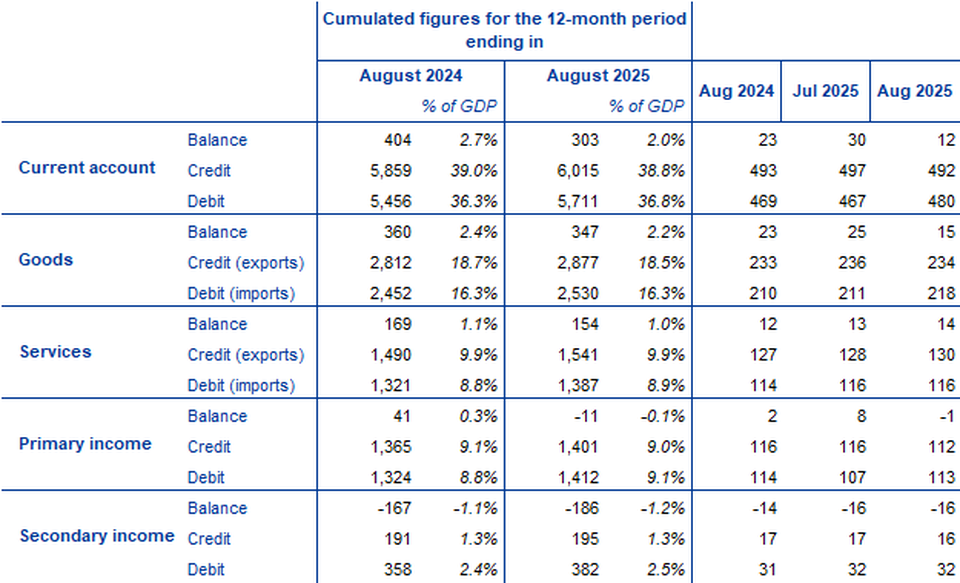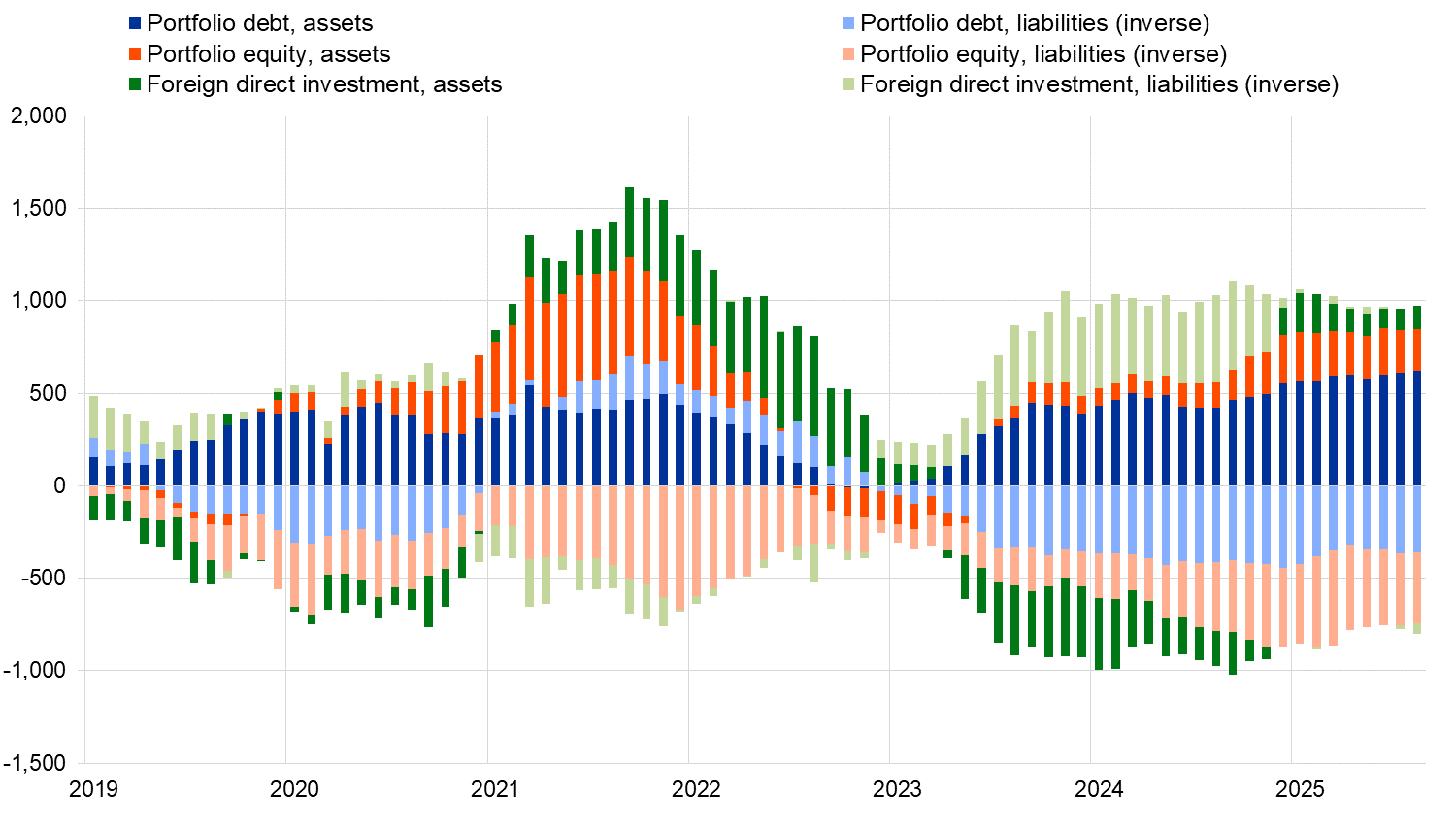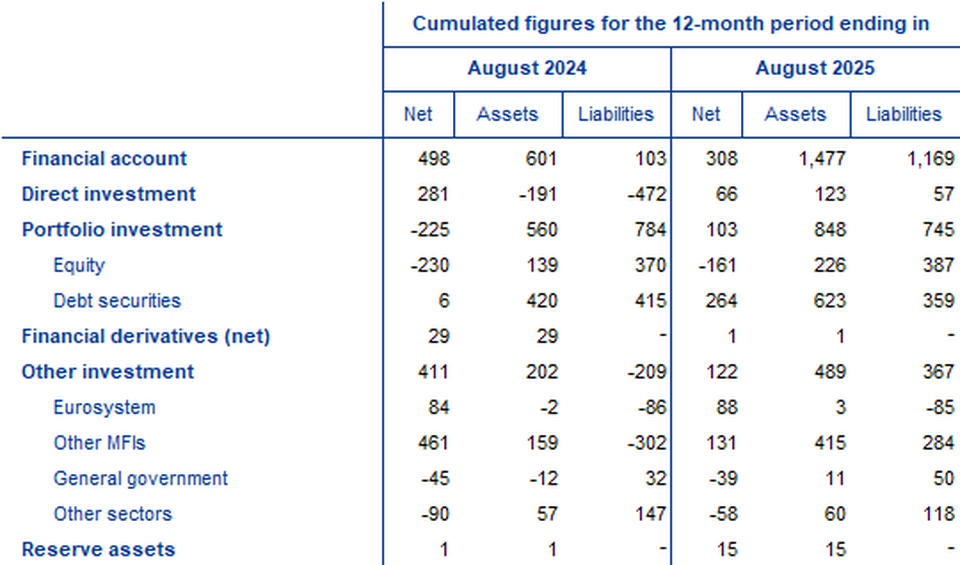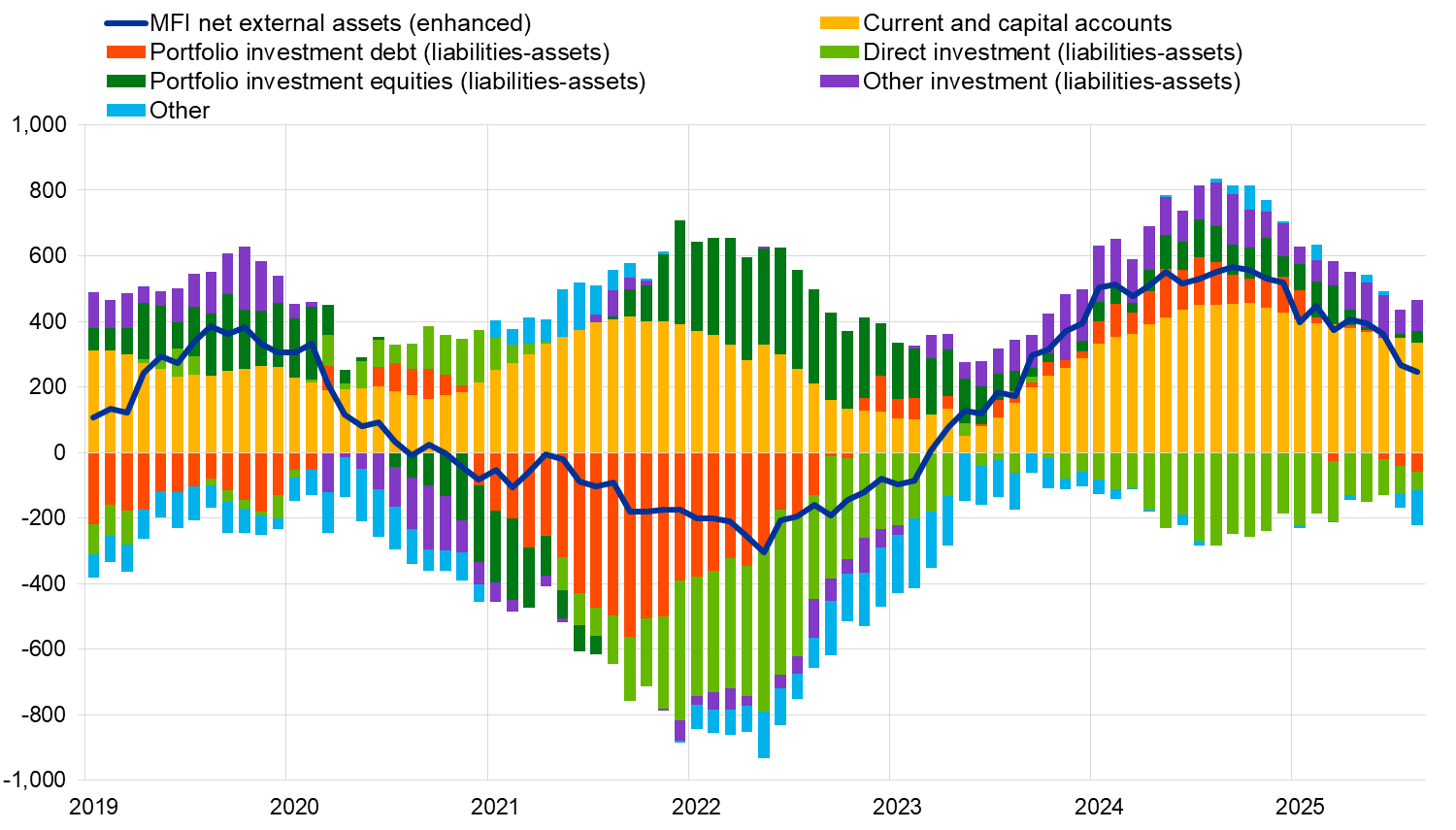One of Harper Lee’s surviving relatives says it’s possible there could be major unpublished works by the author still to be discovered, following the release of eight of her previously unseen short stories.
Describing the mystery…

One of Harper Lee’s surviving relatives says it’s possible there could be major unpublished works by the author still to be discovered, following the release of eight of her previously unseen short stories.
Describing the mystery…

20 October 2025
Euro area current account balance
(EUR billions unless otherwise indicated; working day and seasonally adjusted data)
Source: ECB.
The current account of the euro area recorded a surplus of €12 billion in August 2025, a decrease of €18 billion from the previous month (Chart 1 and Table 1). Surpluses were recorded for goods (€15 billion) and services (€14 billion). Deficits were recorded for secondary income (€16 billion) and primary income (€1 billion).
Current account of the euro area
(EUR billions unless otherwise indicated; transactions; working day and seasonally adjusted data)
Source: ECB. Note: Discrepancies between totals and their components may be due to rounding.
Data for the current account of the euro area
In the 12 months to August 2025, the current account recorded a surplus of €303 billion (2.0% of euro area GDP), compared with a surplus of €404 billion (2.7% of euro area GDP) one year earlier. This decrease was explained by a deterioration of all the accounts, particularly by a switch from a surplus (€41 billion) to a deficit (€11 billion) for primary income, but also by a larger deficit for secondary income (up from €167 billion to €186 billion), and reductions in the surplus for services (down from €169 billion to €154 billion) and goods (down from €360 billion to €347 billion).
Selected items of the euro area financial account
(EUR billions; 12-month cumulated data)
Source: ECB. Notes: For assets, a positive (negative) number indicates net purchases (sales) of non-euro area instruments by euro area investors. For liabilities, a positive (negative) number indicates net sales (purchases) of euro area instruments by non-euro area investors.
In direct investment, euro area residents made net investments of €123 billion in non-euro area assets in the 12 months to August 2025, following net disinvestments of €191 billion one year earlier (Chart 2 and Table 2). Non-residents invested €57 billion in net terms in euro area assets in the 12 months to August 2025, following net disinvestments of €472 billion one year earlier.
In portfolio investment, euro area residents’ net purchases of non-euro area equity increased to €226 billion in the 12 months to August 2025, up from €139 billion one year earlier. Over the same period, net purchases of non-euro area debt securities by euro area residents increased to €623 billion, up from €420 billion. Non-residents’ net purchases of euro area equity increased to €387 billion in the 12 months to August 2025, up from €370 billion one year earlier. Over the same period, non-residents made net purchases of euro area debt securities amounting to €359 billion, following net purchases of €415 billion.
Financial account of the euro area
(EUR billions unless otherwise indicated; transactions; non-working day and non-seasonally adjusted data)
Source: ECB. Notes: Decreases in assets and liabilities are shown with a minus sign. Net financial derivatives are reported under assets. “MFIs” stands for monetary financial institutions. Discrepancies between totals and their components may be due to rounding.
Data for the financial account of the euro area
In other investment, euro area residents recorded net acquisitions of non-euro area assets amounting to €489 billion in the 12 months to August 2025 (following net acquisitions of €202 billion one year earlier), while their net incurrence of liabilities was €367 billion (following net disposals of €209 billion one year earlier).
Monetary presentation of the balance of payments
(EUR billions; 12-month cumulated data)
Source: ECB. Notes: “MFI net external assets (enhanced)” incorporates an adjustment to the MFI net external assets (as reported in the consolidated MFI balance sheet items statistics) based on information on MFI long-term liabilities held by non-residents, available in b.o.p. statistics. B.o.p. transactions refer only to transactions of non-MFI residents of the euro area. Financial transactions are shown as liabilities net of assets. “Other” includes financial derivatives and statistical discrepancies.
The monetary presentation of the balance of payments (Chart 3) shows that the net external assets (enhanced) of euro area MFIs increased by €245 billion in the 12 months to August 2025. This increase was driven by the current and capital accounts surplus and euro area non-MFIs’ net inflows in other investment and portfolio investment equity. These developments were partly offset by euro area non-MFIs’ net outflows in other flows, direct investment and portfolio investment debt.
In August 2025 the Eurosystem’s stock of reserve assets increased to €1,507.8 billion up from €1,499 billion in the previous month (Table 3). This increase was driven by positive price changes (€13.8 billion), mostly due to an increase in the price of gold, and, to a lesser extent, by net acquisitions of assets (€1.2 billion) which were partly offset by negative exchange rate changes (€6.2 billion).
Reserve assets of the euro area
(EUR billions; amounts outstanding at the end of the period, flows during the period; non-working day and non-seasonally adjusted data)
Source: ECB. Notes: “Other reserve assets” comprises currency and deposits, securities, financial derivatives (net) and other claims. Discrepancies between totals and their components may be due to rounding.
Data for the reserve assets of the euro area
Data revisions
This press release incorporates revisions to the data for July 2025. These revisions did not significantly alter the figures previously published.
Next releases:
For media queries, please contact Benoît Deeg, tel.: +49 172 1683704.

An experimental film should be approached in the same open-minded spirit in which it was created, but I must confess to being more or less defeated by this opaque, inert, micro-budget work from Canadian director Rhayne Vermette, who has worked…

The long-running legal battle between ValueLicensing and Microsoft over the resale of software licenses has taken another turn following Microsoft’s attempt to make the case about copyright.
The litigation has rumbled since 2021, beginning with…

Samsung Electronics has unveiled a complete redesign of Samsung Newsroom, its official online communications channel — transforming it into a visually driven platform centered on video, graphics and other types of…
On October 18, in the Republic of Tajikistan, at the “Fakhrabad” training ground, under the general supervision of Deputy Chief of the CSTO Joint Staff Major General Ilkhomjon Hafizoda, instructor-methodological training…

When cancer spreads, tiny amounts of cells can break away from tumors and circulate in the bloodstream. A liquid biopsy is a means to detect the presence of cancer by detecting these cancer cells floating in blood samples. However, current…


The discount retailer B&M has ousted its finance chief after reporting a £7m accounts blunder that will cut its annual earnings – its second profit warning within two weeks.
The company told investors it looking for a successor to Mike Schmidt, who is stepping down as chief financial officer, after the accounting error.
The company, which sells things ranging from DIY, electricals and garden products to toys, pet food and everyday essentials, discovered that £7m of overseas freight costs were not “correctly recognised in cost of goods sold,” after an update to its operating system earlier this year.
This means that adjusted profits for the year to March 2026 are now expected to be between £470m and £520m, down from its previous estimate of between £510m and £560m. For the first half, B&M expects profits of £191m, down from £198m.
Shares in the FTSE 250-listed company slumped by nearly 18% in early trading. They have lost nearly 50% of their value this year.
The retailer said Schmidt will remain with the group until a replacement is found. The system issue at the centre of the problem has since been fixed, it said.
B&M will commission an external review, and will provide a further update when it releases first-half results on 13 November.
One of Britain’s biggest discount retailers, it has been struggling and warned on profits earlier in October. It announced a “back to basics” plan under its new chief executive, Tjeerd Jegen, who took the helm in June.
It expects UK sales at stores open for at least a year to either fall, or rise in low single digits, this year.
Jegen said in early October that the company had cut prices and was working to refocus its ranges, improve on-shelf availability and “bring back excitement to our stores”.
after newsletter promotion
B&M also issued a profit warning in February, and in June blamed sliding sales on more cautious consumer spending, particularly among lower-income shoppers who are its main customers.
In a short statement on Monday, B&M said: “The board wishes Mike well for the future.”
B&M, founded in 1978, became one of Britain’s most successful retailers during the pandemic, when it was still run by the Arora brothers, Simon and Bobby. They acquired the business from Phildrew Investments in late 2004 when it was an ailing regional chain of 21 stores, and built it into a retail empire in the UK and France. It listed on the London Stock Exchange in 2014.
The company has 1,270 stores, mostly in the UK under the B&M, Heron Foods and B&M Express brands. The figure also includes 140 B&M shops in France.

The OnePlus 15 is set to be announced in China on October 27. Ahead of the launch, OnePlus has been teasing the phone’s design and key features. The company recently confirmed the phone’s display specs, and has now revealed its battery…